The really lovely hot weather that we have been enjoying, has meant that on a couple of mornings we have got up to thick fog. Not to worry, this is the best time to see the beauty of spider’s webs glistening in the sunlight when the sun eventually burns the fog away. Rather than just comment on the pictures I thought I would dig up a few facts, so all my information comes from Wikipedia and now I will share them with you, along with the photos I took a few mornings ago.
The word Cobweb is derived from a very old obsolete word – coppe – which meant spider, therefore coppe web = spider web.
Webs are woven from proteinaceous spider silk which is extruded from spinnerets.
The earliest spider’s web was found in some amber in southern England. The amber is 140 million years old.
The difference between spider webs and cobwebs is that spider webs are still in use, cobwebs are webs that have been abandoned.
Most spiders have 3 pairs of spinnerets, each gland produces thread for a special purpose, eg, trailed safety line, sticky silk for trapping prey or fine silk for wrapping it.
Constructing a web is an energetically costly process because of the large amount of protein required in the form of silk. After a while it loses its stickiness and therefore becomes inefficient at catching prey.
It is not uncommon for spiders to eat their own web daily to recoup some of the energy used in spinning. The silk proteins are thus recycled.
The tensile strength of spider silk is greater than the same weight of steel and has much greater elasticity.
At the moment spider silk’s micro structure is under investigation for potential applications in industry, including bullet proof vests and artificial tendons.
I’ll end with my favourite photo which I used in a previous post. Looking at this web with its spider at the centre, from all the new facts that I have now absorbed, I now look at spiders and their webs in a new light -how about you? Are you the sort of person who just brushes them out of your way or do you see the beauty of spider’s webs like I do and admire them as a wonderful creation of nature?

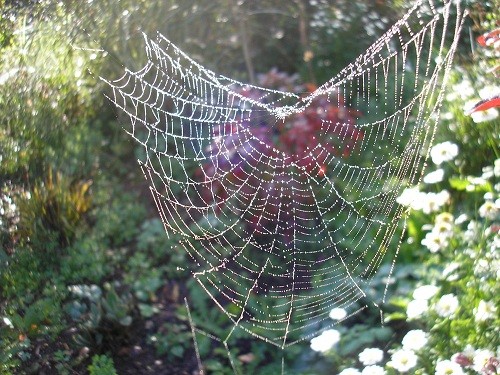

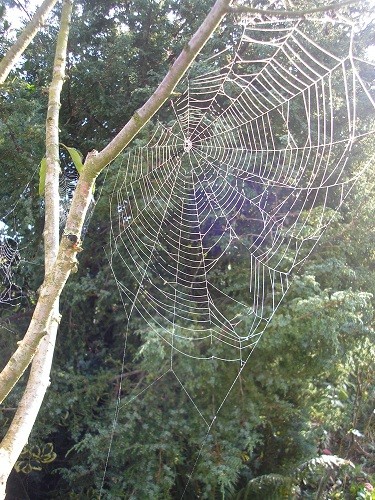
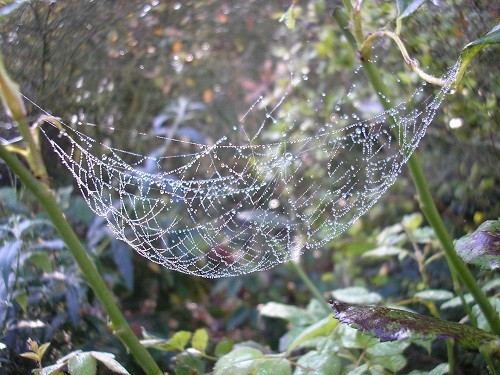

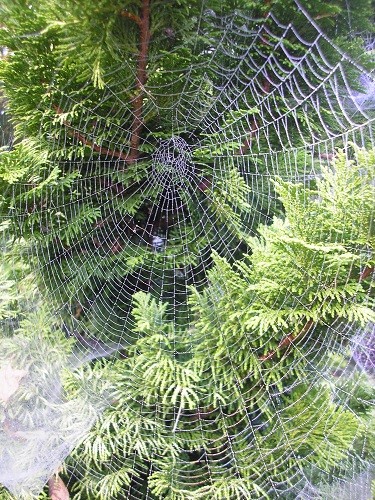




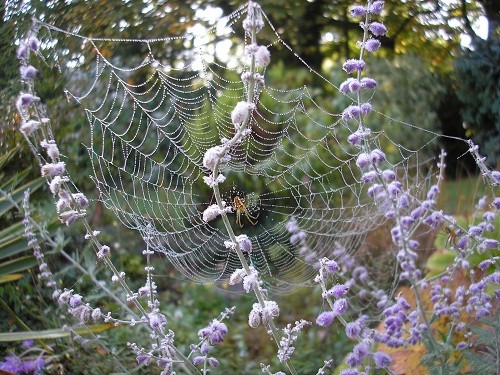
Those are some absolutely beautiful photographs Pauline. Do you suppose the spiders find your garden a buffet of tasty butterflies and bees? I am sure there is a correlation between your variety of flowers and beneficial insects and visits by Charlotte and her relatives.
As far as admiring them. I must admit I do, but from afar.
Tim, I do hope that the spiders aren’t eating the bees and butterflies, they are far too precious, we need them for pollinating everything! Instead I hope they are catching all the flies and midges that bite us as we are gardening. Nice to see that you have given my spider a name!!!
beautiful Pauline and thanks for the info some I knew but some is new to me, a few years ago I saw a spider weaving it’s web on the outside of my window, as there was a sheet of glass between us I looked closer and was fasinated at the speed, it was using the 2 longest ‘legs’ and ‘pulling’ and laying the skein as it moved, I watched for several minuets completely fasinated by it, I wonder way we don’t get so many spiders webs here lol as I wrote that the answer came ~ wind! thanks for sharing, Frances
How amazing Frances, to have watched a spider making its web, so close to you, I would have loved to have seen that. Yes, I think your wind is responsible for the lack of webs where you are, it would have to be in a very sheltered spot to survive and catch all your midges for you!!
actually Pauline I should have included this in my post will next time but the midge is a food source for many small birds, they don’t bite birds, there was a programme on radio Scotland some years ago, also the grub/larve lives in the soil all winter and conditions the soil so not all bad, just so unusual for October, Frances
Thanks for coming back to me Frances, nice to know that midges are not all bad and that they are a good food source for your birds.
what superb photos and fascinating info. I love spiders and when their webs cover the paths I either go round or under and to avoid walking through and destroying all that work. I intend to photograph them but generally the light either isn’t right or I can’t be bothered getting the camera. Wonderful post, thank you.
Thank you Catmint for all your lovely comments – so glad you go round them and don’t waste all their efforts! Do you have poisonous ones in Australia, I think I might feel differently about them!!
I love the web against the brick wall. I think spiders are fascinating, especially their webs. There is a family of spiders called cob spiders and I guess they produce cob webs. But the term must have been extended to all spider webs.
Glad you like spiders’ webs Carolyn. Its interesting that you have a variety of spider called cob spiders – fascinating how language changes as people migrate to other countries.
Pauline you published some amazing pictures, really. Finally I understood the difference between cobweb and spiderweb. English sometimes lacks of significant words to say something or use and reuse and abuse the same word for several meanings and yet… it distinguishes inhabited webs from abandoned ones. It’s funny to me.
The picture I liked most is the tunnel on lonicera nitida.
I know, Alberto, the English language even confuses us sometimes, I’m so glad I didn’t have to learn it as a foreign language!
Glad you like the photos, just had to get out there with the camera when I saw them all glistening in the sunshine.
most are not poisonous, especially the fiercest looking tend to be not poisonous.
Thanks for getting back to me Catmint, glad most of yours are friendly too.